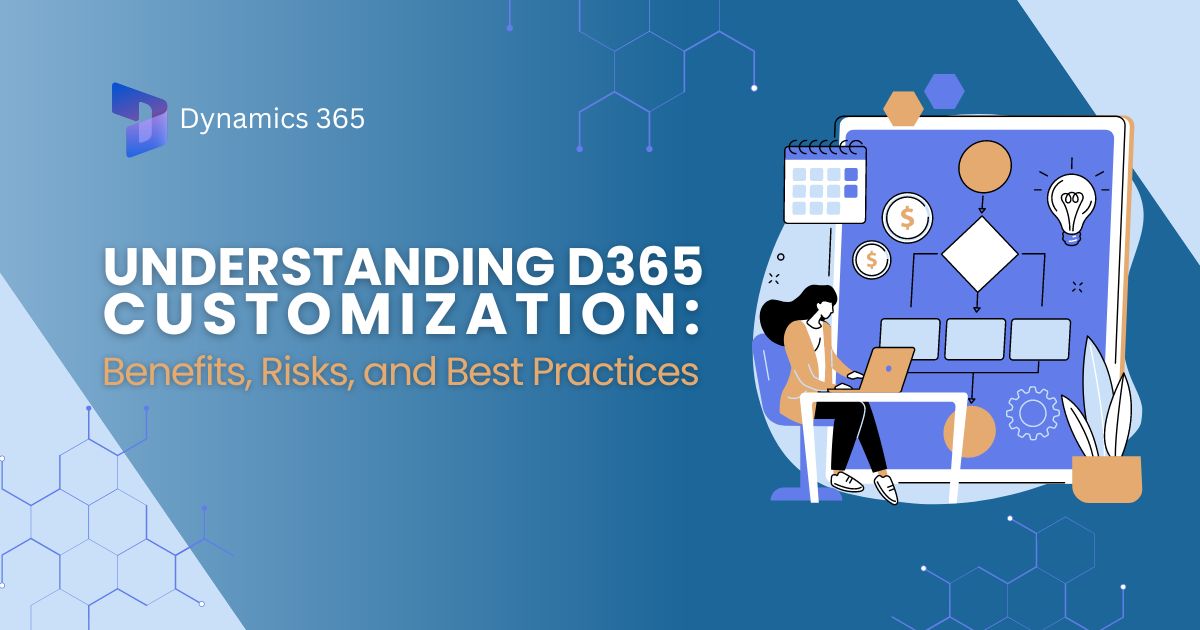
Understanding D365 Customization: Benefits, Risks, and Best Practices
One of the most significant factors in ERP implementation failures is excessive customization. However, many companies gravitate toward Microsoft’s Dynamics 365 Finance and Supply Chain Management (D365) for its relatively ease of customization. Most companies fail to recognize that flexibility can be a double-edged sword, and those customizations may end up costing them money rather than giving them a return on their investment.
In this article, I will draw on my 30+ years of ERP implementation experience to compare the risks and benefits of customizing D365. I will highlight key factors for you to consider before deciding if customization is necessary or if there are more cost-effective and efficient solutions to meeting your requirements. By the end, you will have a better understanding of the pros and cons of customizing D365 and be able to make an informed decision for your organization.
Table of Contents
3 Common Risks of D365 Customizations
Customizing your ERP system brings with it significant risk, and unfortunately those risks don’t end after the system is implemented. Here are three of the major risks associated with ERP customizations:
Increased Cost of Ownership: Customizations always raise the total cost of ownership for the ERP system. In the case of D365, Microsoft releases new service updates four times per year. If you have customizations, that means you will need to have a process to perform regression testing against the updates and your customizations to test for “breaking changes”. This can be a costly process.
Irrelevancy: As D365 continues to evolve, you may find your customizations becoming irrelevant. It is surprising how many times I have seen older customizations providing functionality that was added by Microsoft after the customizations had already been implemented.
Limiting Existing Functionality: I’ve observed several clients make customizations that eliminate the ability to use existing functionality, only to later realize that they need the original functionality due to changes in their business. Attempting to reinstate the disabled functionality takes additional time and resources.
Given the risks and challenges of customizations, why do people still choose to customize their D365 ERP system? There are three primary reasons: they either want to add functionality, modify existing functionality, or they want to integrate other systems with D365. This article will outline the factors you should consider when deciding to customize the functionality in your D365 ERP system, and I will cover the risks and recommended mitigations for integrations in a future article.
When to Customize D365 for Increased Functionality
One of the most common reasons for customizations is because the business has requirements that simply are not addressed by the ERP system they have chosen. Most companies have a “secret sauce,” or a unique process that sets them apart from the competition. When it comes to digital transformations, it’s critical to adopt technologies that allow the secret sauce to not only continue to exist but also to thrive and scale with the business. In most cases, this requires some amount of customization within the system.
For example, we had a client that chose D365 because it met most of their business requirements, but it didn’t meet their unique subcontract requirements. Our client subcontracted a portion of their production and had very unique requirements for those subcontract transactions. Because their subcontracting requirements were so unique, they were unable to find an ERP system that met those requirements. They chose to implement D365 and build the custom functionality to meet their subcontracting requirements.
Evaluating the Necessity of Customization: Four Critical Questions
Adding a nonexistent functionality can be a valid reason for customizing your D365 system. However, before you take that plunge, consider asking yourself some questions to ensure the benefits outweigh the potential risks.
Question #1: Is the desired functionality a true requirement?
On multiple occasions, I have worked with a company that claimed they had a unique set of requirements. After some analysis, it became clear that their so-called requirements were simply entrenched habits and they simply haven’t considered any other way. Once we discuss the motives behind their current methods, we can find another way to accomplish the same objectives using out-of-the-box functionality, significantly cutting back on the amount of time, money and effort required for customization.
Before arriving at an answer to question #1, you must be ready to honestly answer the following questions:
- Why must you have this functionality?
- Is this really a differentiating capability for your company?
- What would happen if you did not have this functionality?
- Is there another way to accomplish the same objectives?

Transformation is not easy, but it doesn’t have to be impossible. Take control of your project’s success today and schedule a free 30-minute consultation to find out how Victoria Fide can equip you for transformational success.
Question #2: Is there an existing add-on or solution that provides the functionality you need?
Microsoft has a robust marketplace of Independent Software Vendors (ISV) offering specialized solutions that have been verified to be compatible with D365. Before opting to build customized functionality, you should exhaust all ISV options for your special requirements. These options have already been built and tested, which significantly reduces the risk of customization.
Question #3: Is there a standalone system that provides the functionality you need?
Integrating systems has become increasingly practical in today’s business software environment. If the functionality you need is supported by a specialized business application, there is a good chance you can integrate that functionality into D365 rather than adding it to D365 through customization.
Question #4: Is there an alternative ERP system that meets all your requirements without the need for customizations?
Sometimes people gravitate toward a particular ERP system, even if it isn’t the best fit. For example, I once had a client that, after observing how D365 handled most of their business requirements, were adamant about implementing it. The entire selection committee wanted D365, despite the fact that it didn’t meet their specific pricing and commission requirements.
They planned to purchase D365 and simply customize it to fit their unique needs. Fortunately for them, the D365 vendor advised against that decision, as the required customizations would have been incredibly intrusive, adding significant risk and cost to both the system’s implementation and its long-term maintenance.
If there is another ERP system that meets all your business requirements, you should strongly consider that system, even if it doesn’t operate as elegantly as D365. If the missing functionality is important enough to customize D365, it may be important enough to live with a less-than-elegant solution. You need to consider implementing the system the fits your “secret sauce” the best.
When D365 “Optimizations” Don’t Pay Off
Sometimes D365 meets a client’s requirements, but they just don’t like the way in which it does it. Usually, the client believes it is a matter of efficiency. I have heard many clients say, “We don’t want to take all the steps that D365 requires for that task.” I can sympathize with the desire to optimize forms and remove clicks to make a task more efficient. However, I have seen these attempts at “optimization” create larger problems for the company later.
For example, one of my manufacturing clients customized D365 to automatically register the production quantity and report a production batch order as finished with the click of a button. It was much more efficient than prompting the user to enter quantities. There was only one problem: their batch runs were not precise, and they never produced exactly the amount their orders called for. That also meant that they didn’t consume the exact quantity of the ingredients in the recipe. As a result, their finished goods inventory was never correct, nor was their ingredients inventory.
They accepted this because they conducted a physical inventory each month and fixed any discrepancies. They also manually performed all their order scheduling and supply planning and didn’t believe they needed highly accurate inventory. When they tried to implement MRP, however, their inaccuracies due to their “optimization” made it impossible to use master planning.
I generally advise clients to never skip steps and cheat the system, as the work required by the system is usually necessary. If you want to optimize the system, find ways to optimize while still accomplishing exactly what the system requires.
In the example above, if the client had integrated their batch mixing system into D365, they could have automated the Report-As-Finished functionality by having the mixer report the exact amount it produced rather than skipping the registration process.
As a general best practice, I recommend implementing the system out-of-the-box first and then optimizing the functionality in future phases after you gain a better understanding of the system.

Balancing Customization and Long-Term Benefits with D365
Even though D365 has the ability for extensive customization, that’s not always the best choice. It’s best to carefully consider whether the customization is a true necessity or not, as customizing any ERP system increases total cost of ownership, can result in irrelevancy over time, and can even limit existing functionality.
While customization can be the right solution in some cases, it’s essential to proceed with caution and prioritize maintaining system integrity and accuracy to reduce risks. Implementing out-of-the-box functionality initially and refining processes based on a thorough understanding of the system can mitigate risks and enable sustainable, long-term success.
If you have questions about customizing D365 or need help optimizing the system to best fit your company needs, schedule a free call with me. I would love to hear from you and help you achieve the right balance between customization, efficiency, and cost-effectiveness for your D365 investment.
About the Author
Tory Bjorklund, a seasoned leader in the consulting, manufacturing, and software sectors, currently holds the position of CEO at Victoria Fide. With a remarkable career that spans roles such as CEO, CTO, CIO, and Chief Software Architect, Tory consistently demonstrates his bold and visionary thinking. His enthusiasm for harnessing technology to transform businesses is evident, and he fervently advocates for reshaping conventional norms in digital transformation through Making Change Positive. Connect with him on LinkedIn to follow his journey.
